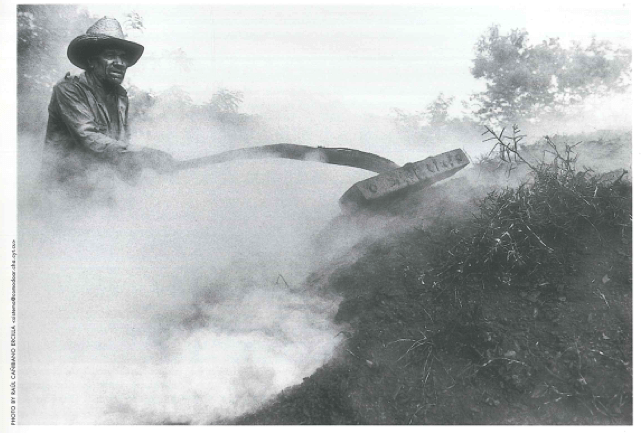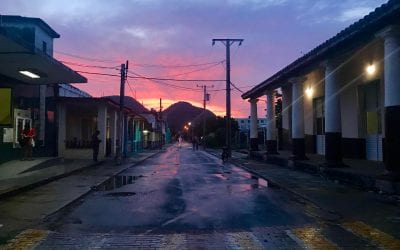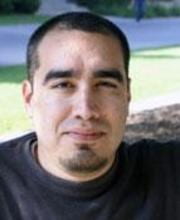Cuba’s Environmental Strategy
Ecologists-by-Necessity

“ A population of rural origins trying to escape from rural poverty” Tierra Guajira (peasant land)
Both in spite of and because of the economic crisis following the collapse of the Soviet Union, Cuba has adopted an ecological perspective on development. Agriculture and other fields experienced major changes in direction. Already existing programs were incorporated into an integral national program that includes agriculture, public health, preservations of biodiversity, alternative energy, environmental education, management of water resources, urban planning, and population growth and movement.
More than any other country, Cuba has taken seriously the resolutions of the 1992 United Nations Conference on the Environment and Development in Rio. The various elements of that program were not new. They were the outcome of more than 30 years of experimentation, innovation, and debate. Their integration represents the final recognition that despite society’s commitment to a rising standard of living, natural limitations will not allow a world-wide consumer society with consumption of energy and materials at Euro-North American levels. Therefore, the improvement of life must emphasize quality of life, cultural development, education, and people taking care of people.
It would be wrong to attribute Cuba’s changes only to the “special period” of pervasive shortages and economic crisis that arose with the disbanding of the COMECON trading block (the Soviet Union, eastern Europe, Cuba, and Vietnam). Despite the popular adage, necessity is not a sufficient mother of invention. Necessity can and often does lead to disaster. There must also be the capacity to respond to necessity, the intellectual and material resources and the flexibility to use those resources. Rather, the emergency of 1989-93 allowed ecological thinking to come to the fore against developmentalist and narrowly economic thinking. The fascination with high tech “modernization” that dominates much of the approach to development in the third world and in international institutions, was to some extent, influential within Cuba itself. The crisis made it possible for the ecologists-by-conviction to recruit ecologists-by-necessity. But the process began long before that.
I have had the privilege of being a participant/observer in this process since 1964, mostly in the development of ecology and ecological agriculture. I watched as botanists and zoologists began to think of themselves as ecologists and to examine the ecological consequences of development. Many a time we sat on the sopping leaf litter of the montane rainforest under the rain (yes, it rains in the rain forest, hard and often!) discussing the role of plant-animal interactions in forest’s formation or debating strategy: should our disputes with the forestry service be raised through the Institute meetings, local government or the Party?
By 1980, we had held the first national ecological conference in Cuba and passed a resolution urging the environment-monitoring agency, the National Commission for the Protection of the Environment and the Preservation of Natural Resources, also have regulatory powers. I recall heated arguments about pesticide use at that meeting. Shortly thereafter, the Commission was raised to cabinet rank and is now part of the Ministry of Science, Technology, and the Environment. In 1988, a conference entitled “Integrated Technology in the Defense of Nature” placed the issues on a national agenda. In the conference’s keynote presentation, I stressed the notion of “modern ecology” to emphasize that modern biology is not only the biology of the very small.
During this initial period, ecology began to gain ground in agriculture, especially in the area of pest control and polyculture. A regular nature program on Cuban television (Entorno, moderated by more former student Jorge Ramón Cuevas) presented information about the natural world to a population of rural origin trying to escape from rural poverty, as well as advocating biodiversity and conservation. Camping became popular in the 1980s, and schools began to teach about nature. The field station in the Sierra del Rosario that had originally been our base for studying the montane forest as Cuba’s contribution to the UNESCO program “Man and the Biosphere” became an environmental education center working with the people, particularly the children, of the Sierra.
But there was still opposition: people who believed that there was only one way to development and that the only questions were, how fast and on whose behalf? The managers of large state farms thought mainly about production and were influenced by the models of agribusiness. Even the increasing use of pesticides since 1959 was still listed in the mid-1980s as one of the achievements of the Cuban revolution. And there was still a current that saw agro-ecology as driven by the sentimental nostalgia of urban intellectuals for a picturesque past that they had never been burdened with. Ecology was criticized as “idealist,” setting goals that were not rooted in socio-technical reality.
This viewpoint was popular but contested. Despite the attractiveness of developmentalist thinking, Marxism also provided a counter-influence. Dialectical materialism emphasizes historicity, context and process, interconnection, the inseparability of the social and the biological and other themes that made an ecological perspective attractive. I was present when one local Communist Party nucleo prepared itself for the debates by honing the argument that far from ecology being “idealist,” it was the height of idealism to suppose that we could pass resolutions and have nature obey.
The debates were often heated, and we didn’t always win. But they had a different flavor from similar debates in this country where scientific issues are so often surrogates for conflicting economic interests. In Cuba, the debates were most simply debates between different points of views rather than interests, so that good argument could win. (This is not completely true: enterprises charged with production and overwhelmed with meeting the population’s needs were often impatient with ecology. A later Cuban document criticizes the assignment of environmental monitoring to the same enterprises that so the polluting. But there was also an agreed-upon national agenda beyond that of the enterprise that allowed the discussion to reach a resolution more readily).

In agriculture, the use of biological control of pests became widespread and centers for the culturing of the natural enemies of pests were set up on the state farms and some cooperatives. Research on biofertilizers led to the spread of nitrogen-fixing bacteria, composintg, use of earthworms, mycohrhizae (fungi that serve as extensions of a plant’s root system in the mobilization of minerals), and recycling strategies. At one point, we had to argue for slowing down the adoption of organic methods to a rate we could guide because misuse could discredit the whole program.
The trajectory in pest management has been from pesticides to the application of natural enemies to the creation of conditions that favor natural enemies and towards a multi-tiered defense system. This sort of defense system starts with the planting pattern (several crops with different vulnerabilities in the same field or adjacent plots that mutually benefit each other, plants that repel or trap pests), an environment friendly to predators and parasites of pests (straw for spiders, nectar sources for wasps, safe nesting sites for ants, protection from pesticides for all of them, as well as birds); the use of insect diseases, and fungi that attack the pests.
With DRCLAS support, my collaborator Tamara Awerbuch and I are currently working with the Cuban Citrus Institute on the ecological and mathematical analysis of population dynamics of one relatively immobile and one mobile herbivore and their natural enemies on orange trees.
In 1992, after the fall of the eastern bloc, Cuba adopted article 27 of its constitution:
“The State protects the Environment and natural resources of the country. It recognizes its close relation with economic and social sustainable development to make human life more rational and to ensure the survival, well-being and security of today and future generations. It is the duty of the appropriate bodies to implement this policy. It is the citizen’s duty to contribute to the protection of water, atmosphere, conservation of the soil, flora, fauna, and all the use of nature’s potential.”
Thereafter, all agencies were required to consider environmental impacts in their planning. This does not mean that they always do so. Especially when there is economic urgency, developers do not always listen to the ecologists. In one case, a stone causeway was built to an offshore cay to stimulate tourism. Ecologists had warned that this would interfere with water circulation and kill the mangroves. When this prediction bore fruit, sections of the causeway had to be removed and replaced by more expensive bridge spans.
When the “special period” struck, there was already an intellectual and institutional base for an ecological strategy. The loss of some 70-80 % of all foreign trade in 1989-90 and the tightening of the U.S. economic blockade made simple survival the top priority. Without imported feed, chickens shrank to the size of pigeons; their eggs were like golf balls. Native breeds that could gather their own food and resist climatic stress became the obvious way to go. High-quality cattle, mostly Holstein bred with a component of native Cebú, could not live on forage alone, and much of the herds were lost. Milk production collapsed. However, by 1995, a modest recovery had begun. It became possible to look critically at all offers of investment and reject the most harmful ones to ecology.
The National Environmental Strategy, formulated in 1997, tries to develop criteria for those decisions. It legally requires all agencies to take environmental issues into account. It encourages grassroots participation through such ventures as organic vegetarian restaurants and seeks to promote environmental awareness. The strategy gives priority to environmentally sound technological research and stresses an active international environmental policy. It seeks to integrate issues of public health, clean production, recycling of urban waste, alternative energy, biodiversity, and education into a comprehensive vision. The more deprived areas of Cuba are to receive the first benefits of eco-friendly technology; the four percent of households not on the national electric grid are prioritized recipients of solar collectors, for instance. Special programs such as an anti-desertification program are being developed for vulnerable regions.
The environmental commitments in Cuba are carried out unevenly. Controversy continues. Recently, at a neighborhood meeting, one fellow insisted on the need to cut down trees interfering with electrical service. Another responded, “Trees are the lungs of the city; they can be pruned if necessary. Don’t cut them down!” The debate continues. However, the whole radical concept of directing the whole development of society toward a non-consumerist, sustainable relation with nature is a departure that warrants close watching.
Winter 2000
Richard Levins, John Rock Professor of Population Sciences at the Harvard School of Public Health, was honored by the University of Havana last year with an honorary doctorate degree. Levins, an internationally recognized U.S. ecologist and bio- mathematician, is considered one of the most prominent authors of mathematical patterns in biological processes. Levins has worked for 33 years as an advisor to the Cuban ERCI government on scientific projects in ecology agriculture, and public health. Most recently, he has started 5 a collaborative relationship between the Human Ecology Group at the Harvard School of Public Health and Cuban institutions.
Related Articles
Isabelle DeSisto: Student Perspective
encountered the first obstacle of my trip to the Isla de la Juventud before I even left Havana. Since American credit cards don’t work in Cuba, I couldn’t buy my plane tickets online. But that…
Honoring Humanity: An “Interview” with Richard Mora
Mauricio Barragán Barajas: Why don’t we begin by having you introduce yourself? RM: Alright. I was born in East Los Angeles, and grew up in Cypress Park, a barrio in…
Tobacco and Sugar
“Tobacco and Sugar” is the course that focuses American literatures on the Caribbean, and that acknowledges the unavoidable importance of monocultures for cultural studies. Much of the…




